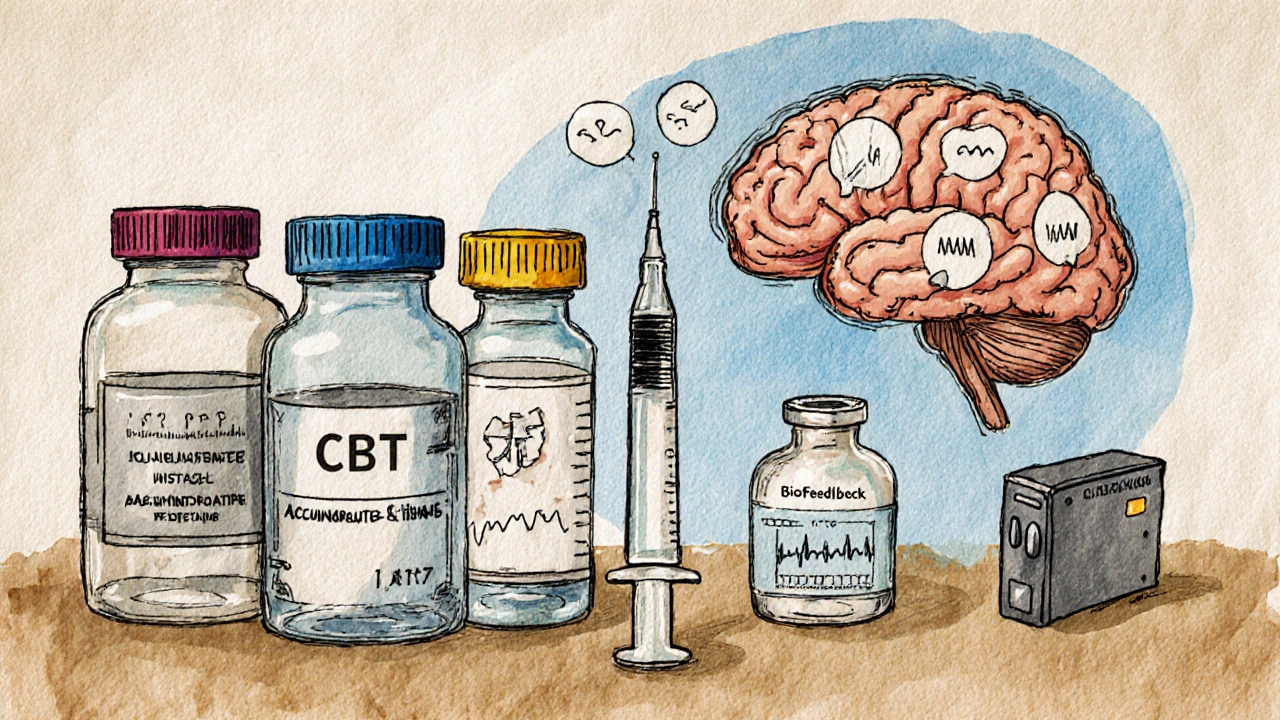Migraine Prevention Plan Builder
Your Personalized Prevention Plan
Migraine prevention involves proactive strategies to reduce the frequency and severity of attacks. This tool helps identify suitable approaches based on your migraine pattern and preferences.
Important: Always consult with a healthcare provider for personalized medical advice.
Living with migraine can feel like a constant battle against sudden, throbbing pain that knocks you out of work, family time, and even simple daily tasks. The good news? Modern medicine and evidence‑based therapies give you a solid chance to keep attacks at bay. This guide walks you through the most effective drugs, non‑drug options, and lifestyle tweaks that together form a comprehensive migraine prevention strategy.
Key Takeaways
- Preventive meds work best when matched to your migraine pattern and side‑effect tolerance.
- Therapies such as CBT, biofeedback, and neuromodulation provide drug‑free relief for many patients.
- Identifying and avoiding personal triggers can cut attack frequency by up to 50%.
- Combining medication with lifestyle changes yields the highest success rates.
- Regular follow‑up with a headache specialist is crucial for fine‑tuning your plan.
What Is Migraine Prevention?
Migraine prevention is a proactive approach that aims to reduce the number, severity, or duration of migraine attacks. Instead of waiting for a headache to start and then treating it, prevention focuses on lowering the brain’s susceptibility to the cascade that triggers pain. It involves daily or regularly scheduled interventions - either medication or non‑pharmacological therapies - that modify the underlying neurovascular processes.
How Preventive Medications Work
Preventive meds fall into several families, each targeting a different mechanism. Below you’ll find the most prescribed classes, their key attributes, typical dosing, and common side effects.
Beta‑Blockers
Beta‑blockers are cardiovascular drugs that dampen the sympathetic nervous system, lowering blood pressure and reducing the frequency of migraine attacks. Propranolol is the most studied, usually started at 40mg daily and titrated up to 160mg. Side effects can include fatigue, cold hands, and occasional depression.
Antiepileptic Drugs (AEDs)
Antiepileptic drugs stabilize neuronal excitability, which helps prevent the cortical spreading depression thought to trigger migraines. Topiramate (25‑100mg nightly) and valproate (500‑1000mg daily) are common choices. Watch for tingling, weight loss, or liver‑function changes with valproate.
Tricyclic Antidepressants
Tricyclic antidepressants such as amitriptyline, modulate serotonin and norepinephrine pathways, providing both pain relief and mood‑stabilizing benefits. Starting doses are low (10‑25mg at bedtime) to avoid dry mouth and drowsiness.
CGRP Inhibitors
CGRP (calcitonin gene‑related peptide) inhibitors are a newer class that blocks a neuropeptide directly involved in migraine transmission. Monthly injections like erenumab (70mg) or quarterly shots such as galcanezumab have shown 50‑60% reduction in monthly migraine days for many patients. Injection‑site reactions are the most common complaint.

Medication Comparison
| Medication Class | Typical Dose | Effectiveness (Reduction in MMD) | Common Side Effects | Notes |
|---|---|---|---|---|
| Beta‑blocker | Propranolol 40‑160mg daily | 30‑45% | Fatigue, cold extremities | Avoid in asthma |
| Antiepileptic | Topiramate 25‑100mg nightly | 35‑50% | Paresthesia, weight loss | Monitor cognitive changes |
| Tricyclic antidepressant | Amitriptyline 10‑50mg at night | 25‑40% | Dry mouth, drowsiness | Beneficial for comorbid depression |
| CGRP inhibitor | Erenumab 70mg SC monthly | 50‑60% | Injection site pain | Cost may be a barrier |
Non‑Drug Therapies That Work
When medication alone isn’t enough-or if you prefer a drug‑free route-several evidence‑based therapies can be layered onto your plan.
Cognitive Behavioral Therapy (CBT)
Cognitive Behavioral Therapy teaches patients to recognize stress patterns and replace negative thoughts that may trigger migraines. A typical course involves 8‑12 weekly sessions, delivering a 20‑30% drop in migraine days.
Biofeedback
Biofeedback uses sensors to help you gain voluntary control over physiological functions like muscle tension and heart rate. Studies show a 30% reduction in attack frequency when practiced consistently.
Acupuncture
Acupuncture involves inserting fine needles at specific points to modulate pain pathways. Meta‑analyses report modest benefits, especially when combined with other strategies.
Neuromodulation Devices
Neuromodulation includes non‑invasive devices like single‑pulse transcranial magnetic stimulation (sTMS) and vagus nerve stimulators. They are FDA‑cleared for migraine prevention and can cut attacks by roughly 40% for responsive patients.
Lifestyle Tweaks & Trigger Management
Even the best meds won’t perform optimally if you keep exposing yourself to known triggers. Here’s a practical checklist.
- Sleep hygiene: Aim for 7‑9 hours, keep bedtime consistent, and avoid screens 30minutes before sleep.
- Diet: Limit aged cheese, processed meats, and artificial sweeteners. Keep a food diary for 4 weeks to spot patterns.
- Hydration: Minimum 2L of water daily; dehydration is a common prodrome.
- Exercise: Moderate aerobic activity (e.g., brisk walking, cycling) 3‑4 times a week improves vascular health and reduces stress hormones.
- Stress management: Daily mindfulness, progressive muscle relaxation, or yoga can blunt cortisol spikes that precipitate attacks.

Putting It All Together: Personalized Prevention Plan
Choosing the right mix feels like solving a puzzle. Follow these steps to craft a plan that fits your life.
- Assess attack pattern: Track frequency, intensity, and disability using a headache diary or a smartphone app for at least 1 month.
- Identify red flags: If you have visual aura, medication overuse, or chronic daily headache, schedule a specialist consult immediately.
- Start low, go slow: If a medication is indicated, begin at the lowest effective dose and titrate upward while monitoring side effects.
- Add a non‑drug layer: Pair the drug with CBT or biofeedback, especially if you have high stress or anxiety.
- Implement lifestyle fixes: Choose three items from the checklist above and integrate them gradually.
- Review every 2-3 months: Adjust dose, switch class, or add another therapy based on reduction in monthly migraine days (aim for ≥50% reduction).
Remember, the goal isn’t just fewer headaches-it’s a better quality of life. Open communication with your GP or neurologist, combined with diligent self‑monitoring, makes that goal reachable.
Frequently Asked Questions
When should I consider preventive medication?
If you experience four or more migraine days per month, or if acute meds no longer give adequate relief, it’s time to talk to a healthcare professional about a preventive regimen.
Do CGRP inhibitors work for everyone?
Not all patients respond, but clinical trials show about 50‑60% achieve a meaningful reduction. They’re especially useful when traditional drugs fail or cause intolerable side effects.
Can I combine two preventive medications?
Yes, many specialists prescribe a low dose of a beta‑blocker together with an AED or a CGRP inhibitor. Combination therapy must be monitored closely for interaction and cumulative side effects.
How long does it take to see benefits?
Most preventive drugs need 6‑8 weeks of consistent use before you notice a drop in migraine days. Behavioral therapies may show improvements within 4‑6 weeks of regular practice.
Are there risks with long‑term use of preventive meds?
Long‑term safety varies by class. Beta‑blockers can affect heart rate and mask hypoglycemia, AEDs may impact bone density, and CGRP inhibitors have a favorable safety profile but are costly. Regular lab work and check‑ups help mitigate risks.
Next Steps
1. Start a migraine diary today - note time, possible trigger, severity, and any medication taken.
2. Book an appointment with a GP or headache specialist to discuss whether a preventive medication fits your profile.
3. Choose one lifestyle change from the checklist and implement it for the next 30 days.
4. If you’re open to therapy, look for a certified CBT or biofeedback practitioner in your area.
5. Re‑evaluate after 8 weeks and adjust your plan based on the results.
Taking these concrete actions puts you in control of your headaches rather than letting them control you.






Mixing meds with lifestyle tweaks can really turn the tide on migraine. Try adding a daily walk, steady sleep schedule, and keep a headache diary to spot triggers.
October 5Janice Rodrigiez